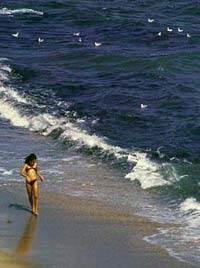ODESSA
 Odessa Ukraine is the 5th largest city in Ukraine and the most important city of trade. Odessa is the largest city along the entire Black Sea. Many years ago, Odessa was once the 3rd leading city in old Russia, after Moscow and St. Petersburg. Odessa looks more like a city located on the Mediterranean, having been heavily influenced by French and Italian styles. Odessa has always had a spirit of freedom, probably endowed to her by her location and by her ability to accept many different peoples.
Odessa Ukraine is the 5th largest city in Ukraine and the most important city of trade. Odessa is the largest city along the entire Black Sea. Many years ago, Odessa was once the 3rd leading city in old Russia, after Moscow and St. Petersburg. Odessa looks more like a city located on the Mediterranean, having been heavily influenced by French and Italian styles. Odessa has always had a spirit of freedom, probably endowed to her by her location and by her ability to accept many different peoples.
 Nearly 1700 years ago, an ancient Greek colony settled near the place where later the city was founded. In the 14th Century, Crimean Tartars traded in the Odessa region.During the Russo-Turkish War, from 1787-1791, the Ukrainian Black Sea Kozaks conquered the Tartar settlement of Khadzhibei and the Turkish fortress of Eni-Dunai, near the city's present-day location. The Frenchman De Ribas helped lead this conquering. Odessa was officially founded in 1794 as a Russian naval fortress on lands annexed from Turkey during the Treaty of Jassy in 1792. The city was named after an ancient Greek colony Odessos (who probably settled near Varna, Bulgaria), and in 1795 it was Queen Catherine II's wish to use this name but in feminine gender, thus Odessa...From 1803-1814, a French politician, Duke de Richelieu, was nominated governor of Odessa.
Nearly 1700 years ago, an ancient Greek colony settled near the place where later the city was founded. In the 14th Century, Crimean Tartars traded in the Odessa region.During the Russo-Turkish War, from 1787-1791, the Ukrainian Black Sea Kozaks conquered the Tartar settlement of Khadzhibei and the Turkish fortress of Eni-Dunai, near the city's present-day location. The Frenchman De Ribas helped lead this conquering. Odessa was officially founded in 1794 as a Russian naval fortress on lands annexed from Turkey during the Treaty of Jassy in 1792. The city was named after an ancient Greek colony Odessos (who probably settled near Varna, Bulgaria), and in 1795 it was Queen Catherine II's wish to use this name but in feminine gender, thus Odessa...From 1803-1814, a French politician, Duke de Richelieu, was nominated governor of Odessa. He had served in the Russian army against the Turks. He did much to promote the integrity and wellness of the city and is considered one of the founding fathers of Odessa.
He had served in the Russian army against the Turks. He did much to promote the integrity and wellness of the city and is considered one of the founding fathers of Odessa.
During 1823-1824, the great Russian poet, Alexander Pushkin, lived and wrote in Odessa. During the Crimean War from 1853-1856, Odessa was bombarded by British and French naval forces. As trade grew, so did Odessa and she became the largest grain-exporting port for Russia. In 1866, the city was linked by rail with Kiev and Kharkov as well as Jassy, Romania. In 1905, Odessa was the site of a workers' revolution, supported by the crew of the Russian battleship Potemkin and Lenin's Iskra. Following the Bolshevik Revolution in 1917 during World War I, Odessa was occupied by several groups, including the Central Powers, the French, the Reds and the Whites. Finally, in 1920, the Reds took control of Odessa and united her with the Ukrainian SSR, later becoming part of the USSR. From 1921-1922, Odessites suffered from a great famine that occurred as a result of the War. During the Great Patriotic War (WWII) from 1941-1944, Odessa was occupied by Romanian and German forces, and she suffered severe casualties. Approximately 280,000 Odessites (mostly Jews) were either massacred or deported.  Some 30,000 Odessites defended their city in honor from some 300,000 Facist troops. Odessa was finally liberated by the Soviet army in April of 1944. During the 1960's and 1970's the city grew tremendously. In 1991, the city became part of newly-independent Ukraine, after the collapse of Communism.
Some 30,000 Odessites defended their city in honor from some 300,000 Facist troops. Odessa was finally liberated by the Soviet army in April of 1944. During the 1960's and 1970's the city grew tremendously. In 1991, the city became part of newly-independent Ukraine, after the collapse of Communism.
Today Odessa is a city of 1.1 million people. The city's industries include ship building, oil refining, chemicals, metal working and food processing. Odessa is also the home of a Ukrainian naval base and fishing fleets. Odessa is situated on terraced hills overlooking a small harbor. The weather in Odessa is mild and dry with average temperatures in January of -2 C (29 F), and July of 22 C (73 F). Odessa averages only 35 cm (14 in) of precipitation annually. Odessa has many therapeutic resorts. The primary language spoken in Odessa is Russian. Ukrainian, however, is the official language and many advertisements and signs are written in it. The city is a diversity of people including Ukrainian, Russian, Moldavian, Greek, Romanian, Bulgarian, Caucasian, Jewish, Turkish, Vietnamese and so forth. Modern Odessa is a city rebuilding herself, and her downtown is slowly being revitalized. Odessa is well-known as the capital of humor, probably due to the great variety of people and her southern location on the Black Sea. Today, Odessa is referred to as the "Pearl of the Black Sea", "Odessa Mama" and "Southern Palmira" by many.

|
Odessa Women Tours
7227 North 16th Street, Suite 240
Phoenix, AZ 85020
(602)553-8178
fax (602)468-1119
Contact Us
|
|
THIS PROGRAM IS THE SOLE PROPERTY OF ODESSA WOMEN TOURS AND MAY NOT BE COPIED IN ANY WAY OR FORM WITHOUT EXPRESS PERMISSION FROM ODESSA WOMEN TOURS.
© COPYRIGHT 1996-2025 - ALL RIGHTS RESERVED.
|
|